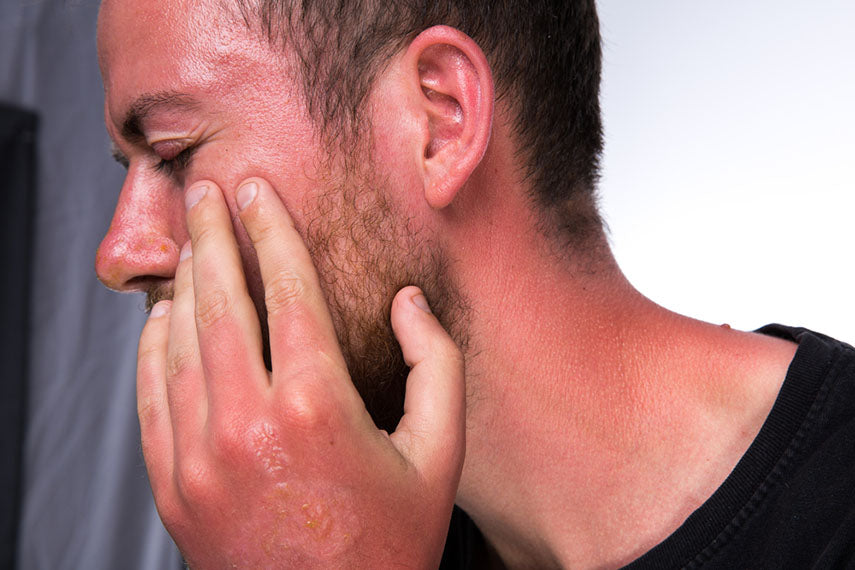Have you ever suffered a sunburn so severe that it made you feel nauseous, feverish and fatigued? These are classic symptoms of sun poisoning, a dangerous type of sunburn that results from prolonged exposure to ultraviolet light.
Sun poisoning may initially manifest as an ordinary sunburn with symptoms such as redness, peeling and discomfort. When your sunburn becomes sun poisoning, you may experience more extreme reactions including flu-like symptoms and severe blisters that pose a risk of infection. Getting sun poisoning just once is more than enough for most people to realize that they never want to experience it again.
With that in mind, here are three things all guys should know about preventing and treating sun poisoning:
- Sun poisoning is a layman’s term for a severe sunburn.
- You can take steps to prevent sun poisoning by wearing daily sunscreen and taking additional sun safety precautions.
- While sun poisoning can sometimes be treated at home, seeking medical attention is recommended for more extreme reactions.
Sun Poisoning—Why Is it a Concern?
Those who care about their skin health know better than to leave the house without wearing a daily moisturizer with SPF. But no one is perfect, and sunscreen mistakes are all too common.
The result of our folly is usually no more than a mild sunburn. Even then, mild sunburns still cause DNA damage and should be avoided.
However, sun poisoning is in a league of its own. Here is why it’s a much bigger cause for concern compared to a regular sunburn:
Increases Risk of Skin Cancer—Researchers have known for decades that the severity of a sunburn likely impacts our risk of developing skin cancer. A 1982 study published in the British Journal of Cancer found a link between young melanoma patients and a history of short but intense periods in the sun that resulted in severe sunburn (see claim pg. 955-956: “…raises the possibility that intermittent intense sun exposure and also prolonged erythema…may be important in the case of cutaneous malignant melanoma.”)
Risk of Infection—Blisters are a common symptom of sun poisoning and need to be treated with care. Left untreated, these small, fluid-filled bumps can burst and become infected or lead to scarring.
Burn Complications—Most mild sunburns fall squarely into the first-degree burn category, while sun poisoning is often categorized as a second-degree burn. When you start dipping into second-degree burn territory, you may start experiencing more serious reactions to your sunburn such as rapid heartbeat, chills, fever, vomiting and confusion.

How to Prevent Sun Poisoning
What steps can you take to avoid sun poisoning? Fortunately, all you need to do is follow the same general sun safety tips for regular sunburn.
Wear Sunscreen Every Day—Be sure to apply a daily moisturizer with SPF to protect the vulnerable skin on your face. Keep in mind that the sun’s UV rays can peek out from clouds, so don’t skip a day just because it looks cloudy!
Avoid the Sun During Peak Hours—Stay out of the sun when UV rays are at their strongest. This is usually between 10 a.m. and 4 p.m. during the summer months.
Buy Sun Protective Clothing—If you’re at a high risk of sunburn and skin cancer, consider investing in SPF clothing. Along with your sunscreen, this will provide added protection from harmful UV rays.
Don’t Forget Your Lips—The skin on your lips is incredibly thin and can become sunburned easily. Protecting your lips with a lip balm containing SPF is crucial to reducing your risk of sun poisoning and skin cancer. Your lower lip sticks out more and is especially prone to sunburn. According to a 2009 study published in Australian Dentistry, 81 percent of new cases of lip cancer occurred on the bottom lip (see claim: “Eighty-one percent of new cases occurred on the lower lip.”)

Treatments for Sun Poisoning
Sun poisoning starts out with symptoms like those of a regular sunburn: redness, irritation and tender skin. If your symptoms begin to worsen, here are a few treatment options, depending on the severity of the reaction:
Hydrate—Both sunburns and sun poisoning can elevate your internal body temperature, dehydrating your body and making you feel tired. Replenish your fluids by drinking at least a few more cups of cold water (preferably with electrolytes) than your normal daily intake.
Reduce the Pain—Use a cold compress to soothe your skin and lower your body temperature. You can also pop an Ibuprofen to reduce the pain.
Take Care of Blisters—Avoid popping or picking at your blisters, as this could lead to infection. Many home remedies for sunburn also work on blisters, such as Aloe Vera or moisturizer.
Know When to See a Doctor—If your sun poisoning symptoms include dizziness, vomiting or fever, seek medical attention immediately. Your body could be going into shock.
Sun Poisoning—Not Even Once
Sun poisoning is more than just a bad sunburn. In some cases, it can be a life-threatening condition that requires immediate medical attention.
If you suspect you have sun poisoning, let others know so they can monitor you. If your symptoms worsen and you become confused, they’ll be able to take you to the hospital.








